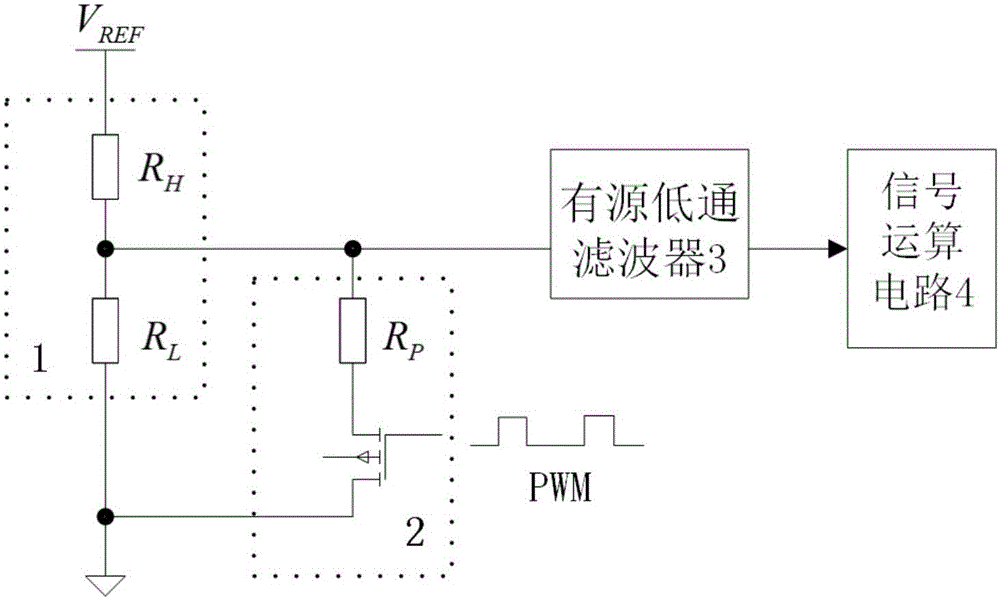Software-controlled base line regulating circuit
A technology for regulating circuits and software control, applied in control/regulating systems, regulating electrical variables, instruments, etc., can solve problems such as large redundancy, high cost, and large ripple, and meet the requirements of DC bias ripple requirements, low cost, and stable voltage
- Summary
- Abstract
- Description
- Claims
- Application Information
AI Technical Summary
Problems solved by technology
Method used
Image
Examples
Embodiment 1
[0028] The software-controlled baseline adjustment circuit designed in this embodiment is as follows: figure 1 As shown, it consists of four parts as a whole: basic voltage division branch 1, parallel branch 2 controlled by PWM, active low-pass filter 3 and signal operation circuit 4. The basic voltage dividing branch 1 is a basic circuit for generating a DC bias voltage. Obtain a stable DC voltage V from the analog circuit part ref , such as obtained from a voltage reference chip, or using the power supply voltage output by a power regulator chip. Use two resistors R with better temperature characteristics for this DC voltage H and R L Divide the voltage to get a basic DC bias voltage, denoted as V H .
[0029] The parallel branch 2 controlled by PWM is composed of a resistor R with better temperature characteristics P It is composed of an N-type MOSFET in series, and this branch is connected in parallel with the low-voltage terminal resistance R of the basic voltage di...
Embodiment 2
[0034] figure 2 It is a certain application occasion of the baseline adjustment circuit of the present invention, and is compared with the existing baseline adjustment scheme.
[0035] exist figure 2 In the application of the differential sensor, the difference between the measured object 5 and the standard reference point 6 is converted into a voltage signal. The dc component also fluctuates slowly over time, requiring accurate measurement of all fluctuations in this signal.
[0036] The role of the pre-amplification circuit 7 is to amplify the signal amplitude output by the sensor to match the input range of the ADC, fully utilizing but not exceeding the conversion range of the ADC.
[0037] The function of the signal operation circuit 8 is mainly to perform DC bias on the measured signal, so that the voltage fluctuation range of the measured signal is within the input range of the ADC.
[0038]On-chip integrated PGA ADC9, for different measured objects, the PGA10 integ...
Embodiment 3
[0046] The difference from Embodiment 1 is that the parallel branch 2 controlled by PWM is composed of a resistor R with better temperature characteristics P It is composed of a P-type MOSFET in series, and this branch is connected in parallel with the high-voltage end resistance R of the basic voltage divider branch 1 H superior. The 2 resistors R of the basic voltage divider branch H and R L and the shunt branch resistance R P , these three resistors need to be calculated according to the range that needs to be adjusted for the baseline in practical applications. Since the parallel connection methods of Embodiment 1 and Embodiment 3 are different, the calculated resistance values and adjustment methods are different. All the other are identical with embodiment 1.
PUM
 Login to View More
Login to View More Abstract
Description
Claims
Application Information
 Login to View More
Login to View More - R&D
- Intellectual Property
- Life Sciences
- Materials
- Tech Scout
- Unparalleled Data Quality
- Higher Quality Content
- 60% Fewer Hallucinations
Browse by: Latest US Patents, China's latest patents, Technical Efficacy Thesaurus, Application Domain, Technology Topic, Popular Technical Reports.
© 2025 PatSnap. All rights reserved.Legal|Privacy policy|Modern Slavery Act Transparency Statement|Sitemap|About US| Contact US: help@patsnap.com


